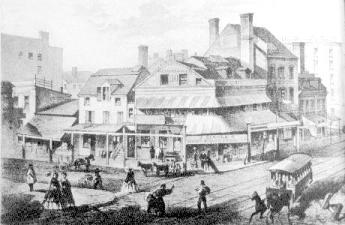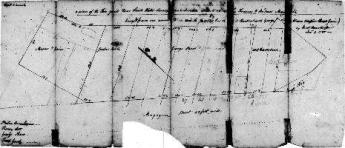Artifacts and everyday life
Backyard features (abandoned privy shafts, cisterns, wells) subsequently used as trash repositories are often the focus of urban archaeology. A wealth of information can be derived from people’s garbage — information about their private lives, their personal choices, and even their political allegiances.
Select this link to view pictures of the artifacts in the photo album.
What do artifacts tell us about everyday life?

Corner of Pearl and Chatham Streets, 1861, as depicted in Valentine’s Manual, 1883
Five Points was always a mixed residential, commercial, and industrial district. Along Chatham Street (now Park Row) retail shops flourished.
Signs advertised shoes, children's clothing, furniture, restaurants, and jewelry. An oyster house stood at 110 Chatham in 1855. Behind it the archaeologists found piles of oyster shells and the foundations of an ice house (Feature AM). The feature was filled with the usual domestic refuse, but the large number of recovered glass tumblers suggested that a substantial amount of drinking took place on the premises.
Artifacts from the features
The Five Points site yielded a trove of more than 850,000 artifacts, only some of which are depicted here. On September 11, 2001 the collection was in storage at GSA’s archaeology lab in the basement of 6 World Trade Center pending relocation to a permanent repository. Sadly, these artifacts were all destroyed with the exception of a few select items, including the Father Mathew teacup, that were on exhibit elsewhere at that time.
The Pearl Street tanneries — MCC tunnel artifacts
A 1785 map shows the courthouse block divided into eight lots that belonged to George and Jacob Shaw, tanners. Taking advantage of the moving water of the eastern outlet of the Collect Pond and standing water in the surrounding swamps, the tanners sited their operations along the sill of land that eventually became Pearl Street.

The Shaw’s property is marked in the center of this 1785 tannery map of the courthouse block
Artifacts found
- Wooden slat from the barrel identified as a liming pit that was found at the northeast corner of the tunnel trench
- Iron hook, which would have been attached to a long wooden handle, used to move hides around in the tanning vats
- Cattle horn cores and miscellaneous bone found buried in a stratum composed of shredded oak bark
- A nearly complete canine skeleton — often found in association with historic tanneries
- Cattle horn cores and miscellaneous bone found buried in a stratum composed of shredded oak bark
The Hoffman assemblage — Feature AF
While the Hoffmans ate on fancy Chinese porcelain dishes, other citizens complained loudly about the industries that were polluting the nearby Collect Pond. In addition to the tanneries, slaughterhouses, breweries, ropewalks, and potteries contributed to making the neighborhood less than desirable. Despite these conditions, artisans continued to live here in order to be near their businesses. The Hoffman bakery (managed by a sequence of tenants) remained in business on Pearl Street well into the 1850s; the widow Hoffman lived on the property until circa 1830 when the Five Points had already achieved its notorious reputation.
Artifacts found
- Hand-painted pearlware tea set, made in England, 1795–1825
- Matching creamware, made in England, 1760–1810
- Chinese porcelain dinnerware, 1780–1800
- Matching creamware, England 1760–1810
- Pearlware pitcher, willow pattern, made in England, 1790–1840
- Two flips with Stiegel-like engraved decoration and pattern-molded fluting, late-18th century
- Unusual Lynn-decorated tumbler, late-18th century
- Two flips and a tumbler
- 18th century wine glasses, one pattern molded (left) and two with air twist stems
- Tumbler and two 18th-century wine glasses
- Dessert glass with pattern-molded ribbing, 18th century
- Salt cellar (top view/side view), late-18th century
- Salt cellar, late-18th century
- Case bottle (probably for gin), made in Holland, late-18th to early-19th century
- Scent bottle, late-18th century
- Medicinal vials, late-18th century
- Preserved food, snuff, or powdered condiment bottle, late-18th to early-19th century
- Porcelain tobacco pipe bowl, made in Germany, late-18th to early-19th century
Irish tenement and saloon — Feature O
For the Irish fleeing the potato famines — as well as for other immigrants — life in New York was an improvement from a material standpoint.
Newly arrived immigrants worked in a variety of skilled and unskilled jobs, including construction, carpentry, masonry, dressmaking, printing, housekeeping, and hat making. Men, women, and even children contributed to the family income which hovered around $600 a year, enough to put meat on the table at most meals and buy fashionable household goods and clothing. For working-class men, life included membership in fraternal orders, trade unions, and fire companies as well as the camaraderie of the many local grog shops. Women formed strong support networks in the tenements, sharing the burden of child care and domestic responsibilities.
Artifacts found
- Matching white granite teaware set, made in England, 1840–1860
- Transfer-printed teawares in common Staffordshire patterns, 1830–1867
- Yellow ware mug; transfer-printed child's cup from the “Games and Pastimes” series (England, ca. 1820); luster ware creamer; and yellow ware (mocha) mug
- White granite chamber pot and lid
- Stoneware beer bottles
- Yellow ware spittoon (American made)
- Pepper sauce bottle decorated in the Gothic style, 19th century
- Figured cologne, and scent bottle, 19th century
- Embossed medicinal bottles
- Embossed patent medicine bottles
- Proprietary medicinal bottles and vials
- Soda water bottles, 19th century
- 19th-century glass ink bottles; master inks (rear), three umbrella bottles (left front), and a rectangular embossed bottle from T.DAVIDS of New York (right front)
- Umbrella part, collar stay, and buckle
- Faux gemstone, glass hygienic syringe, and bone lice comb
- Stone marbles, toy teacup, and jeweler's crucible
- Clay and glass marbles
- A variety of common 19th-century clay pipes, including a bowl molded into a bearded man's head, a Dutch “Peter Dorni” style pipe, and several fluted styles
- Complete examples of two clay pipes; a 19th-century fluted variety, and a “Peter Dorni” style made in Gouda, Holland after 1850
Chatham Street oyster house — Feature AM
The clatter of commerce and the lively street life may have been one of the things that outsiders found so unsettling about Five Points.
On Chatham Street, merchants displayed their wares under awnings outside their shops and peddlers used the streets to hawk theirs. Most of the buildings along this uptown thoroughfare, a kind of workingman's Broadway, had retail shops on the ground floor with apartments above. It may have felt much like Times Square today — full of commercial activity in the daytime and buzzing with entertainment, including theaters, beer gardens, and oyster saloons, at night.
Artifacts found
- Staffordshire vegetable plate decorated with the “Castle of Saint Angelo” pattern, 1840s
- “Old blue” saucer with Lafayette contemplating the tomb of Franklin, French series, Staffordshire, 1824-1835
- “Old blue” pitcher with Lafayette contemplating the tomb of Franklin, French series, Staffordshire, 1824-1835
- Red earthenware porringers
- Red earthenware pitcher
- Red earthenware bank
- Red earthenware pie plate
- Earthenware chamber pot
- Tumblers
- Wine or olive oil bottle
- Wine bottles
- Flacon, probably used to store capers or olives
- Clay tobacco pipe decorated with thistle and rose motif, made in Lincolnshire, England, 19th century
- Clay tobacco pipe with aboriginal figures molded on bowl, made by Thomas Balme of East London, 1805–1840
Needle trades to street musicians — Features H and J
The archaeological remains of hard work and industry stand in stark contrast to contemporary descriptions of Five Points, which were blatantly biased. George Foster, a reporter for the New York Tribune in the 1840s and 50s, described Baxter (then Orange) street as lined with “‘fences’ or shops for the reception and purchase of stolen goods … One who has never seen the squalid undercrust of a fine city would be at a loss to derive any adequate idea, even from the most graphic description, of the sort of building in which the great business of living and trafficking can be carried on. If the reader is a farmer, however, we shall succeed tolerably well in conveying some notion of what we mean. Let him imagine forty of fifty cow-sheds got together in line, furnished with dismal-looking windows, half broken in and patched up with old newspapers — let him imagine half a hundred of these establishments, we say, standing in a row, with a dark paved street and an uneven narrow brick sidewalk in front, and he will not be far behind the reality of the place where we now stand.”
Artifacts found
- Remains of a New World Cebus monkey
- Mother of Pearl buttons
- Sewing related objects, including thimbles, papers of pins, clasps, bone and glass buttons, and a carved tambour (embroidery) hook
- Pressed glass buttons
- Bias tape
- Black cotton thread
- Twill cloth fragment
- “Shoddy” cloth fragment

 U.S. General Services Administration
U.S. General Services Administration
